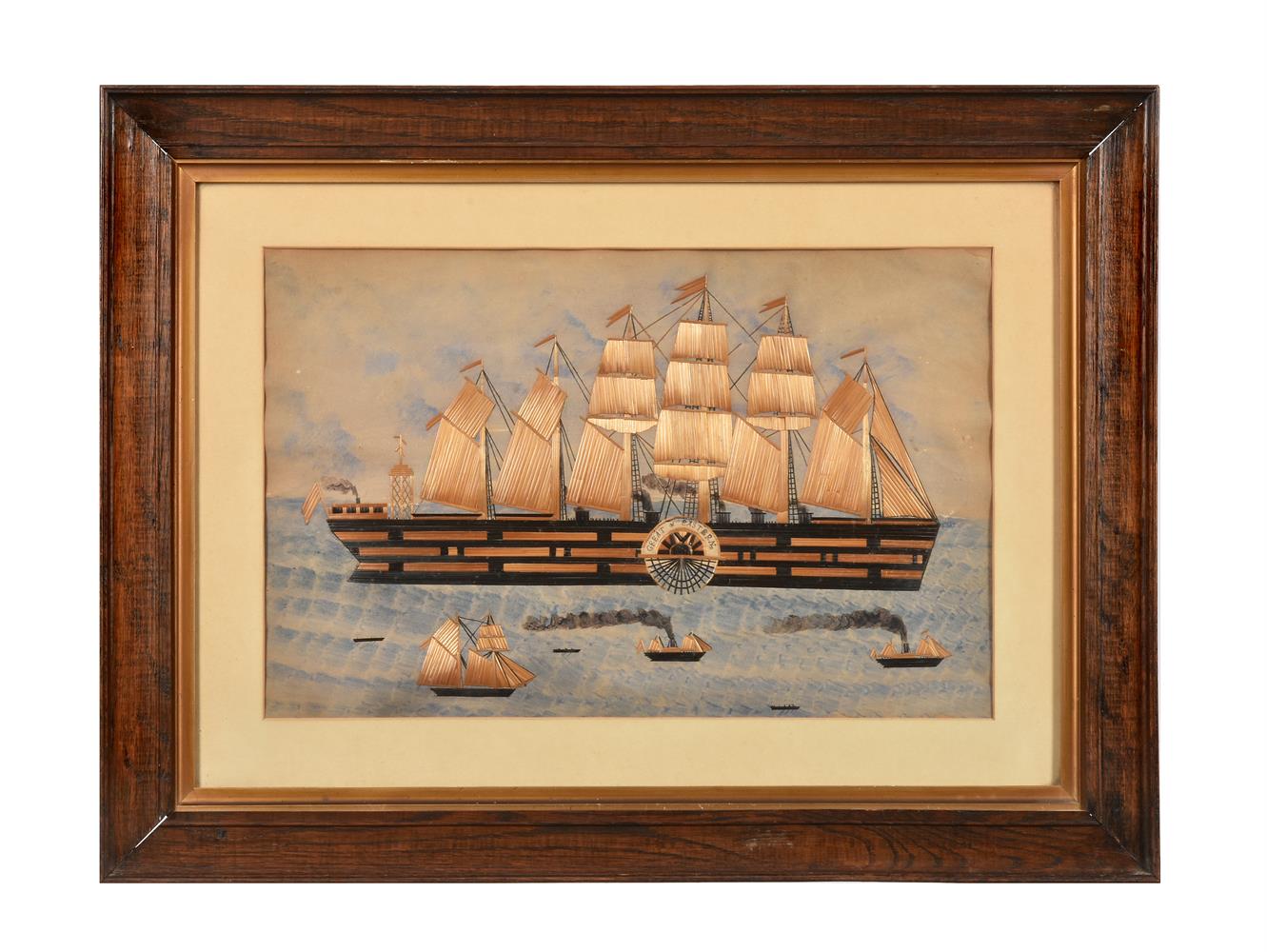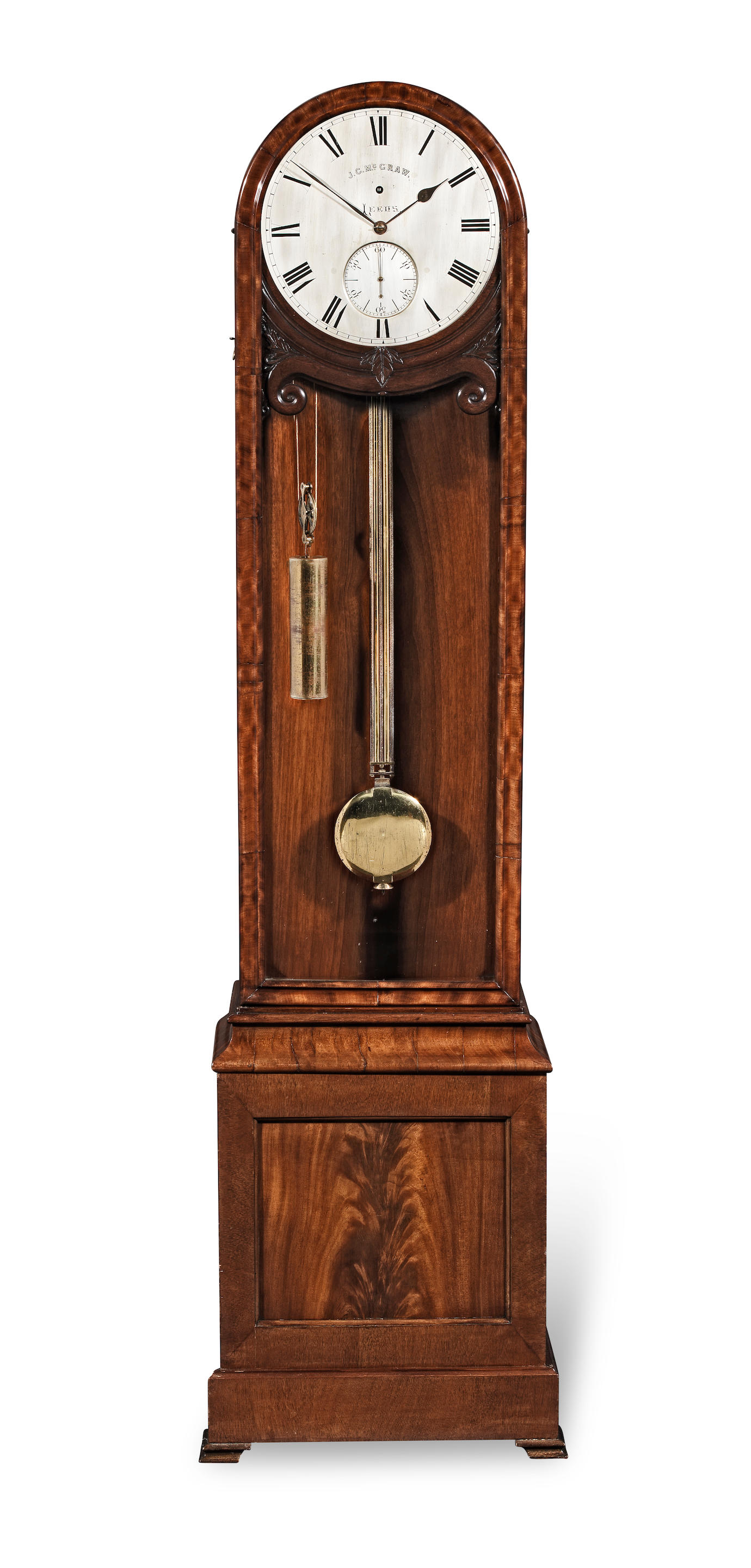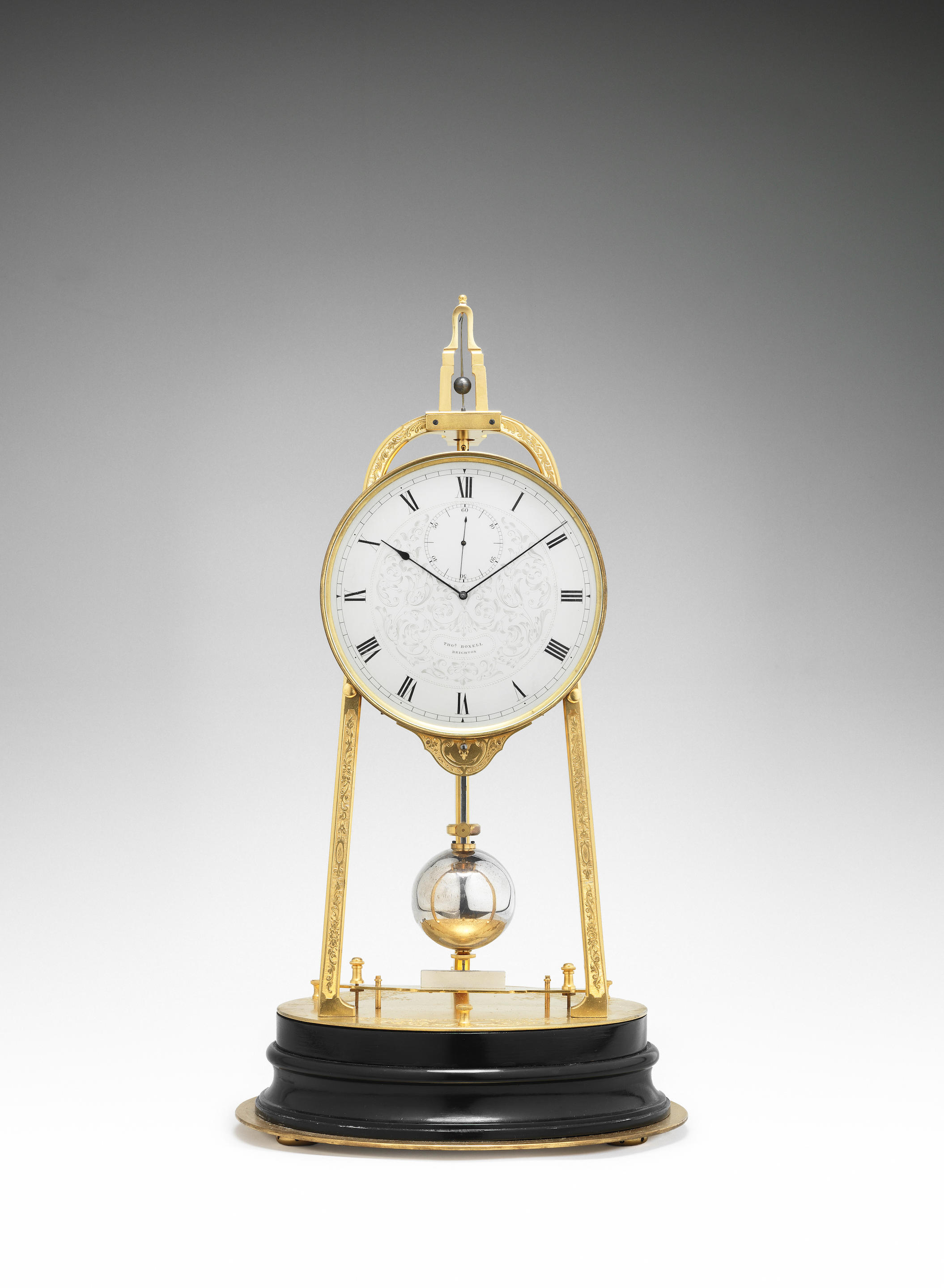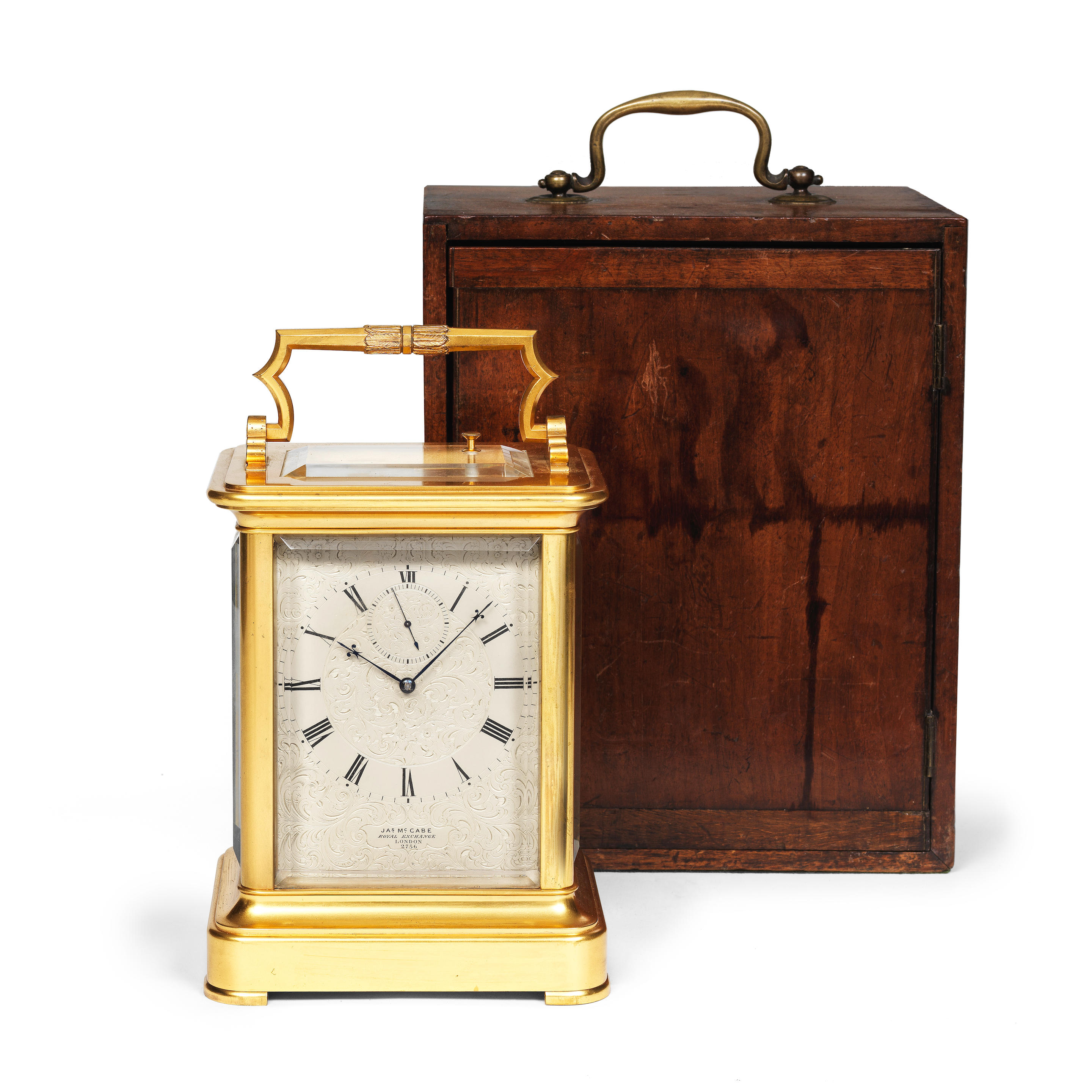A rare mid-19th century Canadian brass-strung mahogany two-day marine chronometer with Lund-type auxiliary compensation and exhibition provenancesigned A. B. Smalley & Son, Saint John, New Brunswick, Number 3712
the three-part case with replaced top lid and double brass strung lines to the front, the centre section with brass 12-point star button above a mother of pearl signature plaque, A. B. Smalley & Son, 3712, the lower section with inlaid brass 12-point star escutcheon and campaign handles. the interior with full length hinge, retaining bar, safety key in its quadrant, gimbal lock and the remains of an applied horological advert....Brewers Canal, Antwerp,
the 3.75"silvered dial signed A. B. Smalley & Son, Makers to the Admiralty, Saint John, New Brunswick, the minute band framing Roman numerals, with gold hands, the subsidiary power reserve dial at XII running from 0-56 in 8 hour increments and instruction to wind at 24 hours, large observatory-style seconds subsidiary between V-VII, and engraved 3712 Auxiliary Compensation in red, the spotted full plate movement with four tapered pillars and maintaining power to the chain fusee, free sprung blued steel helical balance spring with diamond endstone and Earnshaw type escapement, cut and compensated bimetallic balance with timing screws and unique bimetallic auxiliary compensation to the upper end of each of the circular weights, in a weighted, gimballed bowl, punch numbered 2022, with Tipsy key,
20cms highFootnotesPlease note, this lot will be subject to US Fish and Wildlife regulations if imported into the USA
Exhibited 'Your Time', an exhibition by the Northern Section of the Antiquarian Horological Society at Prescot Museum, February-April 2008; Williamson Museum & Art Gallery, Birkenhead February-April 2008. Exhibit P60.
Arthur Ball Smalley was born in London around 1841 and initially worked in the city before relocating to St. John, New Brunswick Canada in 1870 to marry one of the residents, Deborah Tucker May. May was originally from Nova Scotia and was about nine years Smalley's junior; although she describes herself as English, it does not seem that she had ever been to the U.K. before her marriage, which raises the question of how she met Smalley. Interestingly, it states that Smalley's 'point of origin' was Massachusetts; perhaps this was where his ship docked, and he travelled up to New Brunswick from there, or he may have initially established himself in Massachusetts and met May there?
Smalley described himself as a jeweller throughout his career, the British Horological Institute noted that he was 'a leading watchmaker of St. John's, New Brunswick', though it remains unknown to which Company, if any, he served his apprenticeship. He was an occasional contributor to the Horological Journal, particularly as regards chronometers, with which he seemed to have a particular interest. In 1876, he submitted a model of a new marine chronometer balance to the British Horological Institute; it comprised of a backwards Z-shaped balance wheel, with both sections of the arm at right angles to each other.
In 1881, the family was living at 201 Douglas Ave. and it seems likely that the shop was located in a different building. This was certainly the case by 1894, where the shop address was listed as 91 Prince William St. Smalley and May would have seven children including Arthur Cobden, who would become a jeweller as well, and it seems carry on the work in the shop. By 1901, the shop had been renamed from A.B. Smalley to A. B. Smalley & Son.
It is unknown when Smalley died, both he and May were still living in 1917, and attended one of their children's weddings. It is tentatively suggested that they had both died by 1928, though this is far from certain. No records can be found of Arthur Cobden after about 1913; whether he died or simply moved out of New Brunswick is unknown. It is known, however, that the shop at 91 Prince William Street ceased trading in 1919; after this date it became a chocolate makers and then a spice shop. In 2008, the shop gained listed status in New Brunswick and remains famous, among other things, for being the site of Smalley's Jewellery.
John Richard Lund (c.1806-78) took out Patent number 9969 in 1843 as part of the effort to combat the problems caused by middle temperature error in marine chronometers. Essentially, the correcting weight which was attached to the balance had a secondary compensating feature comprising of a bimetallic curb connected to weight held internally on a pivoted arm. The effect of this device under heat was to alter the radius of gyration in a non-linear fashion. The beauty of the design is that these correcting weights could be placed on balances 'after market'. An excellent coloured drawing of his set-up is illustrated in Betts (2017) 'Marine Chronometers at Greenwich', OUP, Figure 4.47.4. The current lot has a similar bimetallic curb attached to both weights, each terminating in a gold screw.
Beta (1902) 'Jottings', The Horological Journal, Vol. 44 (11), pg. 149.
Smalley, A. B. (1901) 'Poole', The Horological Journal, Vol. 44 (2), pg. 24.
Smalley, A. B. (1894) 'Mathews', The Horological Journal, Vol. 37 (3), pg. 42.
Parks Canada (2008) 'Smalley's Jewellery', Canada's Historic Places. Available at: https://www.historicplaces.ca/en/rep-reg/place-lieu.aspx?id=9303
Smalley, A. B. (1894) 'Timing Watches', The Horological Journal, Vol. 37 (1), pg. 13.
Smalley, A. B. (1877) 'American Watchmaking', The Horological Journal, Vol. 19 (7), pgs. 97-98.
Smalley, A. B. (1876) 'Solid Angular Rim Balance', The Horological Journal, Vol. 18 (12), pg. 176-177.
New Brunswick Cananda (2022) Provincial Archives of New Brunswick: Smalley [Online], New Brunswick, Minister of Finance. Available: https://archives.gnb.ca/Search/FEDS/Default.aspx?culture=en-CA&fn=zuWSDOdvu5AynbwtiE4mbNYc7zV25D3uV4vO8iY6DY8=&gn=17cfXq9OXL/4vY3WiHPN75ZkEjrRCjekjSDOEV2ewMM=&y1=1820&y2=1950
A rare mid-19th century Canadian brass-strung mahogany two-day marine chronometer with Lund-type auxiliary compensation and exhibition provenancesigned A. B. Smalley & Son, Saint John, New Brunswick, Number 3712
the three-part case with replaced top lid and double brass strung lines to the front, the centre section with brass 12-point star button above a mother of pearl signature plaque, A. B. Smalley & Son, 3712, the lower section with inlaid brass 12-point star escutcheon and campaign handles. the interior with full length hinge, retaining bar, safety key in its quadrant, gimbal lock and the remains of an applied horological advert....Brewers Canal, Antwerp,
the 3.75"silvered dial signed A. B. Smalley & Son, Makers to the Admiralty, Saint John, New Brunswick, the minute band framing Roman numerals, with gold hands, the subsidiary power reserve dial at XII running from 0-56 in 8 hour increments and instruction to wind at 24 hours, large observatory-style seconds subsidiary between V-VII, and engraved 3712 Auxiliary Compensation in red, the spotted full plate movement with four tapered pillars and maintaining power to the chain fusee, free sprung blued steel helical balance spring with diamond endstone and Earnshaw type escapement, cut and compensated bimetallic balance with timing screws and unique bimetallic auxiliary compensation to the upper end of each of the circular weights, in a weighted, gimballed bowl, punch numbered 2022, with Tipsy key,
20cms highFootnotesPlease note, this lot will be subject to US Fish and Wildlife regulations if imported into the USA
Exhibited 'Your Time', an exhibition by the Northern Section of the Antiquarian Horological Society at Prescot Museum, February-April 2008; Williamson Museum & Art Gallery, Birkenhead February-April 2008. Exhibit P60.
Arthur Ball Smalley was born in London around 1841 and initially worked in the city before relocating to St. John, New Brunswick Canada in 1870 to marry one of the residents, Deborah Tucker May. May was originally from Nova Scotia and was about nine years Smalley's junior; although she describes herself as English, it does not seem that she had ever been to the U.K. before her marriage, which raises the question of how she met Smalley. Interestingly, it states that Smalley's 'point of origin' was Massachusetts; perhaps this was where his ship docked, and he travelled up to New Brunswick from there, or he may have initially established himself in Massachusetts and met May there?
Smalley described himself as a jeweller throughout his career, the British Horological Institute noted that he was 'a leading watchmaker of St. John's, New Brunswick', though it remains unknown to which Company, if any, he served his apprenticeship. He was an occasional contributor to the Horological Journal, particularly as regards chronometers, with which he seemed to have a particular interest. In 1876, he submitted a model of a new marine chronometer balance to the British Horological Institute; it comprised of a backwards Z-shaped balance wheel, with both sections of the arm at right angles to each other.
In 1881, the family was living at 201 Douglas Ave. and it seems likely that the shop was located in a different building. This was certainly the case by 1894, where the shop address was listed as 91 Prince William St. Smalley and May would have seven children including Arthur Cobden, who would become a jeweller as well, and it seems carry on the work in the shop. By 1901, the shop had been renamed from A.B. Smalley to A. B. Smalley & Son.
It is unknown when Smalley died, both he and May were still living in 1917, and attended one of their children's weddings. It is tentatively suggested that they had both died by 1928, though this is far from certain. No records can be found of Arthur Cobden after about 1913; whether he died or simply moved out of New Brunswick is unknown. It is known, however, that the shop at 91 Prince William Street ceased trading in 1919; after this date it became a chocolate makers and then a spice shop. In 2008, the shop gained listed status in New Brunswick and remains famous, among other things, for being the site of Smalley's Jewellery.
John Richard Lund (c.1806-78) took out Patent number 9969 in 1843 as part of the effort to combat the problems caused by middle temperature error in marine chronometers. Essentially, the correcting weight which was attached to the balance had a secondary compensating feature comprising of a bimetallic curb connected to weight held internally on a pivoted arm. The effect of this device under heat was to alter the radius of gyration in a non-linear fashion. The beauty of the design is that these correcting weights could be placed on balances 'after market'. An excellent coloured drawing of his set-up is illustrated in Betts (2017) 'Marine Chronometers at Greenwich', OUP, Figure 4.47.4. The current lot has a similar bimetallic curb attached to both weights, each terminating in a gold screw.
Beta (1902) 'Jottings', The Horological Journal, Vol. 44 (11), pg. 149.
Smalley, A. B. (1901) 'Poole', The Horological Journal, Vol. 44 (2), pg. 24.
Smalley, A. B. (1894) 'Mathews', The Horological Journal, Vol. 37 (3), pg. 42.
Parks Canada (2008) 'Smalley's Jewellery', Canada's Historic Places. Available at: https://www.historicplaces.ca/en/rep-reg/place-lieu.aspx?id=9303
Smalley, A. B. (1894) 'Timing Watches', The Horological Journal, Vol. 37 (1), pg. 13.
Smalley, A. B. (1877) 'American Watchmaking', The Horological Journal, Vol. 19 (7), pgs. 97-98.
Smalley, A. B. (1876) 'Solid Angular Rim Balance', The Horological Journal, Vol. 18 (12), pg. 176-177.
New Brunswick Cananda (2022) Provincial Archives of New Brunswick: Smalley [Online], New Brunswick, Minister of Finance. Available: https://archives.gnb.ca/Search/FEDS/Default.aspx?culture=en-CA&fn=zuWSDOdvu5AynbwtiE4mbNYc7zV25D3uV4vO8iY6DY8=&gn=17cfXq9OXL/4vY3WiHPN75ZkEjrRCjekjSDOEV2ewMM=&y1=1820&y2=1950















Try LotSearch and its premium features for 7 days - without any costs!
Be notified automatically about new items in upcoming auctions.
Create an alert